Bennemann K.H., Ketterson J.B. Superconductivity: Volume 1: Conventional and Unconventional Superconductors; Volume 2: Novel Superconductors
Подождите немного. Документ загружается.


848 J.Zasadzinski
range of the composition phase diagram. All nearby
chemical phases are insulating and the parent phase
is an antiferromagnetic insulator. Thus the early ce-
ramic materials had thick, insulating dead layers on
the surfaces (thwarting attempts at STM measure-
ments) along with nanoscale sized grains which pro-
duced charging effects in tunnel junctions. One such
charging effect, the Coulomb’s staircase, exhibited
current-voltage (I-V) characteristics quitesimilar to
that expected from an s-wave superconducting gap,
leading to much confusion over the magnitude and
pairing state symmetry of the gap. A review of the
early tunneling efforts was given by Gray et al. [40]
and a later review by Kirtley [41] showed improve-
ments in junction quality resulting from the growth
of HTS crystals, such as La
2−x
Sr
x
CuO
4
.
By 1992 most of the interesting oxide supercon-
ductors had been studied by some form of tunnel-
ing spectroscopy using one or more of the junc-
tion configurations of Fig.˜refeps0. The review by
Hasegawa and Kitazawa [22] published at that
time showed that there was mixed success. The bis-
muthate, Ba
1−x
K
x
BiO
3
(BKBO), reproducibly exhib-
ited a clean, BCS-like gap structure (see Fig. 15.2)
indicating s-wave superconductivity. Higher energy
spectral features in the range 20 meV – 70 meV re-
sembled strong-coupling phonon structures which
were analyzed using the MMR procedure to obtain
˛
2
F(!) [6]. But this was controversial because inter-
grain Josephson switching produced structures in
this energy range as well [42]. The issue was re-
solved by Samuely et al. [43] who applied a large
magnetic field to quench any Josephson switching
and the resultant ˛
2
F(!) spectra were in agreement
with Huang et al. [6]. Further support for electron–
phonon coupling in Ba
1−x
K
x
BiO
3
was found when
the tunneling spectral function was successfully used
to fit the d.c. electrical resistivity in overdoped com-
pounds with T
c
near 20 K [5]. However, BKBO is not
completely understood. The optical response is in-
consistent with standard electron–phonon coupling
and can only be explained by assuming weak cou-
pling to an unspecified high energy excitation near
0.4 eV [44]. Such an excitation might be related to
the nearby CDW phase that develops with even slight
underdoping from the optimal T
c
value of 30 K.
Comparing the state of the field in 1992 to the
present, some interesting developments and changes
in perspective have occurred. Early measurements
on the electron-doped cuprate, Nd
2−x
Ce
x
CuO
4
,in-
cluding tunneling, penetration depth, Raman and
photoemission were all consistent with s-wave pair-
ing [6, 45], however more recent results, including
tri-crystal ring experiments, indicate d-wave sym-
metry [7]. Thus there is a resurgence of interest in
this cuprate. Although high quality single crystals
and epitaxial thin films of YBa
2
Cu
3
O
7
had been de-
veloped early, the tunneling spectra were confusing.
Theenergygapstructureappearedverymuchbroad-
ened and in many cases a large ZBCP anomaly was
found. It was later discovered that this ZBCP was due
to the unusual effects that a d-wave gap has on quasi-
particle scattering processes (see the section on novel
d-wave effects). Now studies of the ZBCP are being
used to search for more exotic pairing states,includ-
ing broken time-reversed symmetry states.
Much clearer tunneling gap features were gener-
ally found on Bi
2
Sr
2
CaCu
2
O
8
(Bi2212)which was at-
tributed to the ability to cleave such crystals, leaving
an atomically smooth surface for vacuum or point
contact tunneling. Using STM or PCT methods re-
sulted in c-axis tunneling which eliminatedanyZBCP
anomalies as well.Nevertheless,there was much scat-
ter in the magnitude of the energy gap reported by
Hasegawa et al. [22]. It is now understood that this
spreadof gaps is due to a strong dependence of thein-
trinsic gap on doping concentration and it has taken
a new generation of high quality Bi2212 crystals to
unravel this mystery.At the present time there exists
a great deal of reproducibility among tunneling spec-
trainBi2212,notonlyin thesizeoftheenergy gapbut
in the overall spectral shape. Therefore this material
will be discussed in detail. The other cuprates men-
tioned will also be given further attention as they are
exemplary, providing a focus for the specific issues
of pairing mechanism and gap symmetry.
15.5.1 Nd
2−x
Ce
x
CuO
4
High quality tunneling spectroscopy measurements
of Nd
2−x
Ce
x
CuO
4
(NCCO) were reported by Huang
et al. in 1990 [6]. At that time there was little dis-
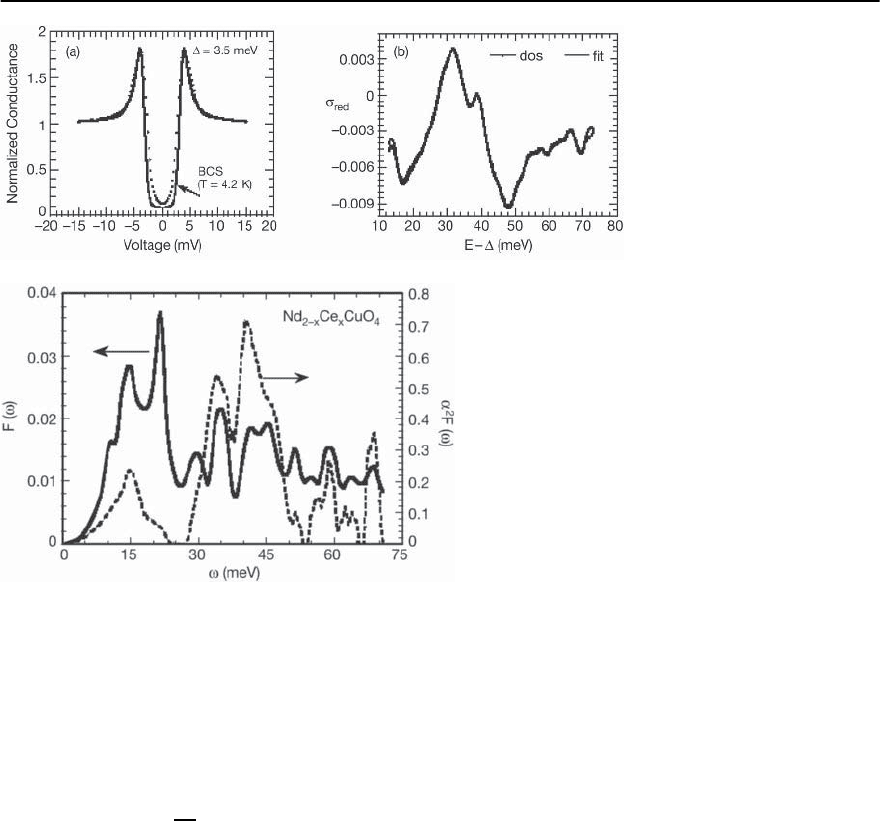
15 Tunneling Spectroscopy 849
Fig. 15.17. (a)Normalizedtun-
neling conductance of NCCO
in the gap region (dots)and
s-wave BCS fit (solid line). (b)
Phonon fine structure observed
at higher bias voltages in the re-
duced conductance and corre-
sponding fit from the MMR in-
version
Fig. 15.18. Comparison of phonon density of states ob-
tainedfrom neutron scattering with ˛
2
F(!),from Tral-
shawala et al. [5]
cussion of d-wave superconductivity.Thegap region
tunneling conductance shown in Fig. 15.17 is rea-
sonably described by a conventional, s-wave BCS fit
with thermal smearing and a small leakage conduc-
tance of 10%. However, the fit to BCS is not ideal
as is observed with BKBO. The gap parameter, =
3.5 meV–3.7 meV, was found on 20 junctions mea-
sured on three different crystals. Using 3.6 meV as
the average leads to
2
kT
c
=3.8 indicating moderate
coupling strength within an s-wave picture.
Inversion of the fine structure in the high bias
conductance was done using a modified version of
the MR procedure to include the small damping ef-
fect of a proximity layer on the surface. This MMR
procedure converged and led to the ˛
2
F(!)spec-
trum in Fig. 15.18. This is compared to the measured
neutron F(!) on the parent Nd
2
CuO
4
where good
agreement is found. It is important to stress that the
MMR procedure is iterative and if the high bias fine
structures are due to extrinsic sources then this pro-
cedure will not converge. Convergence is thus the
first sign that there is physical significance to the
fine structure. More importantly the ˛
2
F(!)spec-
trum leads to a calculated T
c
that is very close to the
measured value of 22 K [6]. The resulting coupling
constant, =1.0, is close to that expected based on
the measured strong-coupling ratio. Thus there are
no inconsistencies in the tunneling data or the s-
wave analysis, and the conclusion of predominantly
phonon-mediated pairing in NCCO seems justified.
The observation of half-integral flux quanta in tri-
crystal ring experiments on NCCO has led to the con-
clusion thatthis a d-wave superconductor[46].While
d-wave symmetry mightexplain thepersistent quasi-
particle sub-gap tunneling conductance in NCCO, it
appears that electron–phonon coupling still plays a
role in the superconductivity of this material. The
presentstate of affairs thus has contradictory aspects,
since it isnot obvioushowto make d-wave supercon-
ductivity and the observed electron–phonon cou-
pling compatible. For example, the measured strong-
coupling ratio in NCCO makes sense in an s-wave

850 J.Zasadzinski
picture but it is significantly smaller than the weak
coupling limit value of 4.26 for d-wave pairing [8].
This is to be contrasted with higher T
c
hole-doped
cuprates where the measured strong-coupling ratios
are larger than 4.26,as expected,and where such fine
structure from phonons is not observed in any re-
producible manner. Instead, the measured tunneling
spectra are consistent with pairing interactions that
are dominated by electron–electron interactions that
naturally give rise to d-wave superconductivity.
Perhaps in NCCO electron–electron interactions
are present, but necessarily weaker, since T
c
is quite
small compared to the hole-doped counterparts.
Nevertheless, it might be energetically favorable for
the competing interactions to settle on a d-wavepair-
ing state. However, it is unlikely that the resultant
momentum dependent gap would have the simple
BCS form considered in Sect. 15.2.1. Furthermore,
since d-wave superconductivity is sensitive to disor-
der, there might be local regions where a competing
s-wave state wins out. It is safe to say at present that
there are new questions to be resolved for NCCO.
15.5.2 Bi
2
Sr
2
CaCu
2
O
8
The generic spectral features of Bi2212 have already
been discussed for STM and PCT respectively, see
Fig. 15.20. These features can be separated according
to energy scale.When viewed at the highest energies
(out to 1 eV) the conductances are consistent with a
broad peak centered near the Fermi energy which is
mostlikely dueto theband structure DOS [31].While
the peak itself is obscured by the superconducting
gap, its effect is to produce a decreasing background
out to 300 meV. The sharp conductance peaks indi-
cate the gap for quasiparticle excitations.At energies
of the order two and three times the gap energy there
are dip and hump features with a strength that is
generally asymmetric in bias voltage. However, the
degree of asymmetry of the dip feature seems to de-
pend on the type of junction.Aswill be shown, some
STM measurements show nearly symmetric dip fea-
tures in the normalized data,whereas PCT junctions,
whichaverageoveramuchlargercontactarea,always
display a large asymmetry.
These basic characteristics are evident for all dop-
ing levels, changing only in energy scale.An example
of PCT conductance data for a slightly overdoped
Bi2212 crystal is shown in Fig. 15.19 from the work
of Ozyuzer et al. [47]. Note the strong asymmetry
of the dip feature, being most pronounced for bias
voltages which remove electrons from the supercon-
ductor. The raw data have been compared to a BCS
d-wave fit which provides an excellent fit to the sub-
gap conductance.This indicates that the normal state
(or background) conductance is approximately con-
stant in the subgap region. The cusp at zero bias is
acharacteristicofad-wave gap and this feature has
been seen in the PCT data of Tl2201 (see Fig. 15.4) as
well as in many spectra on Bi2212.However, for bias
voltages eV > there is no agreement. The simple
BCS d-wave fit cannot explain the asymmetric dip
Fig. 15.19. PCT tunneling conductance of overdoped
Bi2212 (dots)andd-wave fit (solid line), from Ozyuzer
et al. [47]
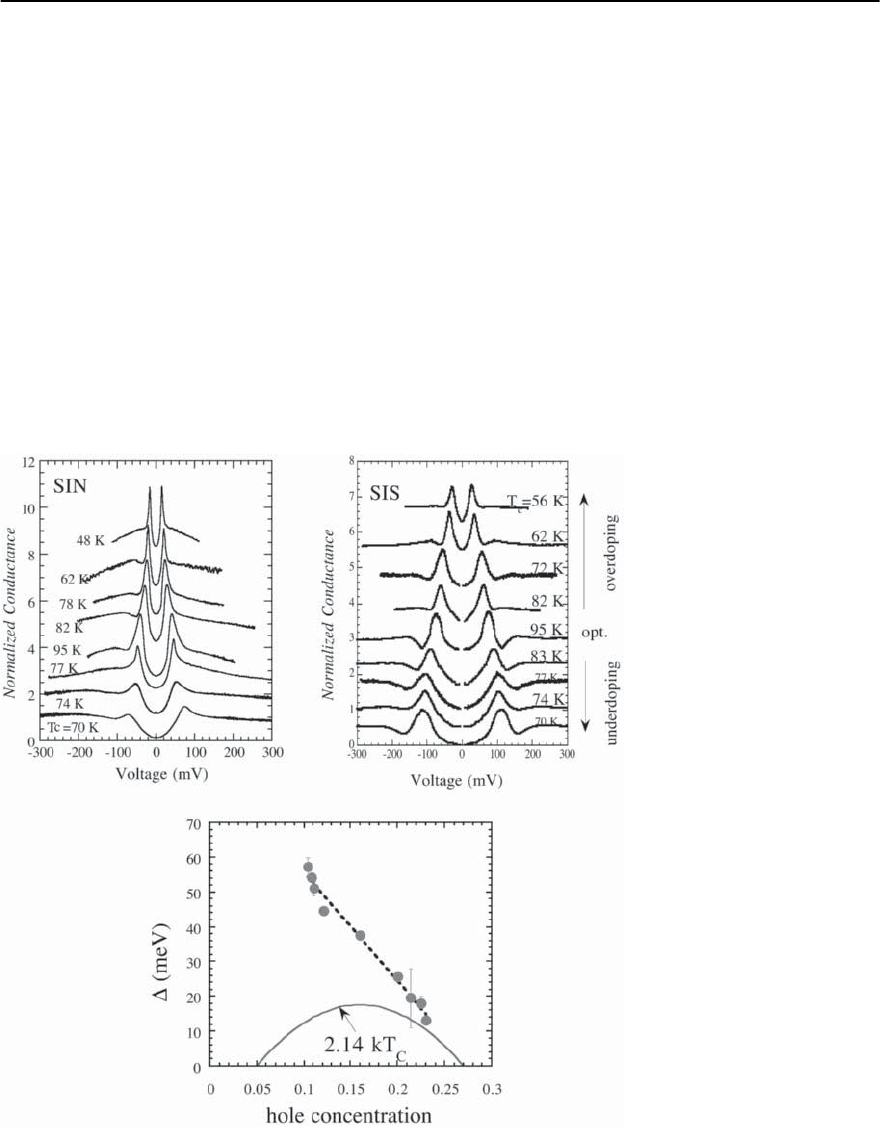
15 Tunneling Spectroscopy 851
feature or the decreasing background. In addition
the conductance peaks are wider than the fit curve
andthis is generallytrue for Bi2212data measuredby
STM, PCT, break junctions etc. A closer examination
of Tl2201 in Fig. 15.4 reveals an interesting similar-
ity in the deviation of the conductance data with the
d-wave fit.
The backgroundconductance in Bi2212cannotbe
measured to normalize away those features not asso-
ciated with strong coupling effects as done with Nb
or ZrN shown earlier. This is due to the fact that the
temperatures required to reach the normal state are
>90 K and the background can change when com-
pared to low temperatures.More importantly,the su-
perconducting gap might be evolving into a pseudo-
gap above T
c
in which case one needs to exceed T
∗
to reach the “true” normal state. For the analysis of
high-T
c
cuprates it becomes clear that the all effects
which might be contributing to the low temperature
conductance, e.g. d-wave superconductivity, strong
coupling effects, band structure DOS, pseudogaps,
etc.,willhavetobebuiltintoanymodelofthetun-
neling conductance. Such a model must also explain
all asymmetries. This situation is obviously much
more complex than found in conventional supercon-
ductors and leads to ambiguities in interpretation of
tunneling spectra.
In order to gain insight into the spectral features
the Argonne group has performed tunneling mea-
surements of Bi2212 over a wide doping range from
underdoped (T
c
= 70 K) to optimal doped (T
c
=
95 K) to overdoped (T
c
= 48 K) [48,49]. Doping de-
Fig. 15.20. To p:SIN and SIS tun-
neling conductances vs. dop-
ing obtained from PCT junc-
tions on Bi2212. Bottom:Gap
parameter vs. doping obtained
from all junction types. From
Miyakawa et al. [48,56]
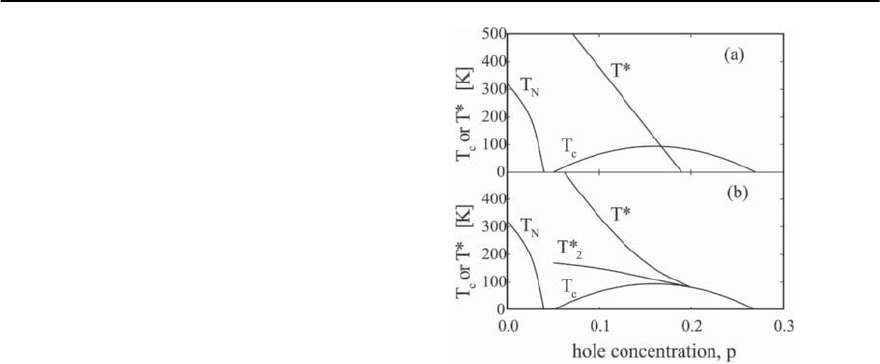
852 J.Zasadzinski
pendent trends have been observed in the energy
gap and dip/hump features. The hole concentration
has been varied by oxygen content. Starting with op-
timal doped crystals, overdoping (underdoping) is
achieved by annealing in high (low) pressure oxy-
gen. Representative SIN conductances and SIS break
junctions are shown in Fig. 15.20. What is evident
is that the energy gap increases monotonically with
decreased doping, even in the underdoped region
where T
c
decreases. This is shown more clearly in
the bottom panel of Fig. 15.20 where the data points
represent averages of a large number of SIN and SIS
junctions. The error bars are small and this indicates
a high degree of homogeneity within a given crystal.
These gap values have also been reproduced in the
STMstudiesof Bi2212by DeWildeetal.[30]andRen-
ner et al. [50,51] and therefore Fig. 15.20 can be con-
sidered intrinsic from the perspective of tunneling.
There is always a question that tunneling might be
sensitive to surfaceeffects,but it should be notedthat
the same magnitudes and trend of gap vs.doping has
also been seen (over a more limited doping range) in
Raman spectroscopy which is a bulk probe [52].
Such an unusual doping dependence to the mea-
sured quasiparticle gap has stirred up considerable
debate, especially since it is directly related to the
issue of a pseudogap observed above T
c
in vari-
ous experimentalprobes of cuprate superconductors.
The various interpretations of the pseudogap can be
grouped into two broad classes [53] as shown in the
schematic phase diagrams in Fig. 15.21. In the top
picture, the pseudogap is depicted as a separate en-
ergy scale, distinct from superconductivity. Possible
origins ofsuch a pseudogap are charge density waves
(CDW), spin density waves (SDW) or more exotic
orbital antiferromagnetism or d-wave density waves
(dDW) [54,55]. In such a view the superconducting
gap more closely follows the doping dependence of
T
c
and therefore the measured quasiparticle excita-
tiongapin Fig.15.20mustrepresenta smoothchange
from purely superconducting character in the over-
doped region to some other type of gap in the under-
doped region. Tallon and Loram have suggested that
various bulk experimental probes such as specific
heat are consistent with this picture [53]. However,
it was argued by Miyakawa et al. [48,56] that such
Fig. 15.21. Schematic phase diagrams for cuprate super-
conductors.In (a) the pseudogap is a separate energy scale,
distinct from superconductivity.In (b) the pseudogap tem-
perature represents some form of precursor superconduc-
tivity
a view is not supported when the tunneling spectra
are examined in detail. In particular, two-gap mod-
els should exhibit two distinct features in the DOS
and therefore in the tunneling conductance,whereas
only a single, d-wavetype gap featureis observed.Al-
though the dDW state allows coherent mixing of the
two gaps, this is true only when mean-field theory
is applicable. The same disorder (fluctuations) that
causes the mean-field dDW gap to become a pseudo-
gap would most likely affect the coherent mixing in
the superconducting state, leading again to distinct
spectral features in the DOS. Furthermore, robust
Josephson currents are observed in heavily under-
doped Bi2212 crystals, indicating that the excitation
gap is linked to a superconducting energy scale [57].
The second viewpoint is indicated in the bottom
graph of Fig. 15.21. Here the crossover temperatures
T
∗
and T
M
smoothly connect to the T
c
curvesuggest-
ing there is break between temperature scales associ-
ated with electron pairing and long-range phase co-
herence, as is likely in cuprates due to the low phase
stiffness [58]. In such pictures, pseudogap phenom-
ena are associated with some form of precursor su-
perconductivity and therefore the measured quasi-
particle gap of Fig.15.20 is the true pairing gap asso-
ciated with superconductivity[59].Thisviewpoint is
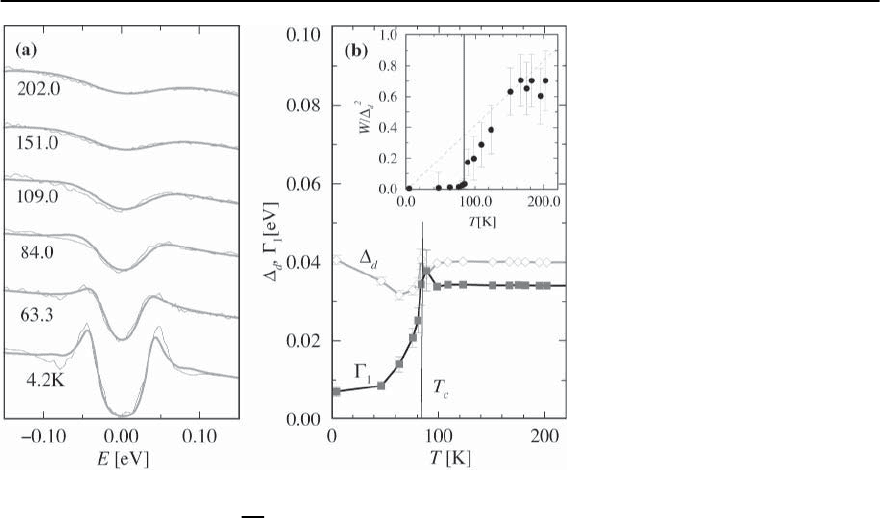
15 Tunneling Spectroscopy 853
Fig. 15.22. (a) STM conductances of
Bi2212 at various temperatures from
Renner et al. [62] and the KT fits of
Franz and Millis,[63]. (b) Resultant en-
ergy gap and scattering rates as a func-
tion of temperature
consistent with the fact that
2
kT
∗
= 4.5-5.5, a reason-
able strong-coupling value [48,60] whereas putting
the measured T
c
in the denominator leads to un-
physically large values, as high as 20. It should be
mentioned here that the notation for the crossover
temperatures differs throughout the literature. The
notation used by Tallon et al. [53] is such that the
uppercrossoverislabeledasT
∗
. This crossover cor-
responds to the temperature where the uniform sus-
ceptibility flattens out and is associated with the de-
velopment of short range magnetic order. Moreoften
itis referredtoasT
M
(asitishere)orT
0
anditismore
common to see the lower crossover listed as T
∗
.Itis
also possible that the upper crossover corresponds
to the development of some type of pseudogap as-
sociated with magnetic order, such as an incipient
SDW [61]. This would then suggest that there might
be two pseudogaps,with the lower crossover temper-
ature T
∗
generally associated with the development
of a pairing gap from superconductivity.
It might seem that a measure of the tunneling gap
vs.temperature would resolve the debate over the na-
ture of the pseudogap, however such measurements
are not easily interpreted. In Fig. 15.22 is shown the
temperature dependent tunneling conductances on
slightly underdoped Bi2212 by Renner et al. using
STM [62]. Qualitatively, the data appear to show a
superconducting gap smoothly merging into a pseu-
dogap of similar energy scale, indicating some form
of precursor superconducting state. The data have
been fit by Franz and Millis [63] using a Kosterlitz–
Thouless (KT) model to describe the phase fluctu-
ations in the pseudogap state. In this model, long
range phase coherence is lost above T
c
by the pres-
ence of vortex/antivortex pairs which also serve to
scatter quasiparticles and turn the pairing gap into a
pseudogap.Support for this type of phase fluctuation
model for the pseudogap comes from a.c. conduc-
tivity measurements of Bi2212 up to 600 GH
z
[64].
The temperature dependence of the tunneling gap
thatresultsfromthisanalysisisofparticularinterest.
(T) decreases by more than 20 percent as T
c
is ap-
proached from below but does not go to zero.This be-
havior is also seen by SIS break junctions (Miyakawa
et al., Ref. [48]) and some intrinsic c-axis junctions
on Bi2212 (as will be shown in a later section). The
break junction data are shown in Fig. 15.23 for an
underdoped Bi2212 crystal with a T
c
=77K.Inthe
Miyakawa et al. work there was no attempt to fit the
data just above T
c
which was a well-defined temper-
ature where the Josephson current went to zero.Thus
in several tunneling studies of Bi2212,there appears
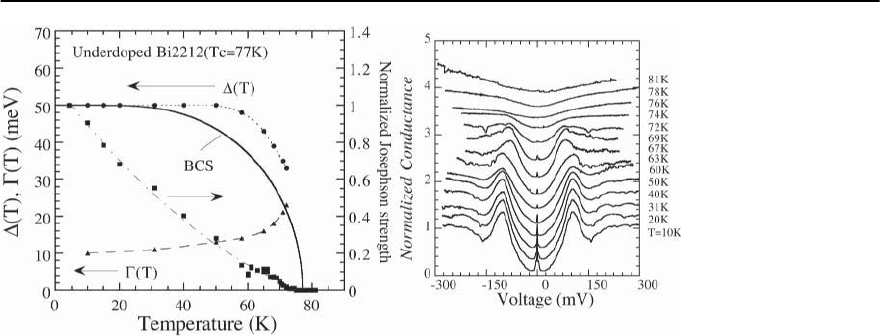
854 J.Zasadzinski
Fig. 15.23. Measured su-
perconducting gap vs.
temperature from SIS
break junctions in un-
derdoped Bi2212, from
Miyakawa et al.[48]
to be evidence that the pairing gap magnitude per-
sists into the pseudogap state,supporting the view of
precursor superconductivity.
However,aninteresting effectis foundin Fig.15.22
just above T
c
where the gap parameter which best fits
the data actually increases. The authors considered
this to be an artifact of fitting the broad tunneling
conductance and fixed the gap magnitude to that of
the low temperature value.Their interest was mainly
in the quasiparticle scattering rate [63]. In this KT
model, the broadening of spectral features above T
c
is due to the fact that the scattering of quasiparticles
has the effect of smearing out the spectral weight
function. More striking behavior is found in other
analyses of temperature dependent gap region tun-
neling conductances which use the ordinary quasi-
particle scattering rate, , along with a d-wave gap
parameter to fit the data [65]. In those studies the
gap magnitude decreases as T
c
is approached from
belowbut thenincreasessubstantially aboveT
c
,often
reaching values that exceed the gap magnitude at low
temperatures. It is difficult to understand this in the
context of any superconducting fluctuation model,
especially since the superconducting gap magnitude
should continue to decrease above T
c
.Rather,these
temperature dependent studies are suggestive of a
second gap in the quasiparticle spectrum, perhaps
associatedwith the uppercrossover temperature,T
M
.
In general it can be said that tunneling data from
STM, PCT, break junctions and some intrinsic junc-
tions (as will be shown) on Bi2212 are consistent and
support the phase diagram shown in Fig. 15.21(b).
Thus the pairing gap persists into the pseudogap
state but there is no long range phase coherence.
The inability oftunneling to clearly and reproducibly
map out the temperature evolution of the supercon-
ducting gap is probably due to the upper crossover
temperature, T
M
, which also gives rise to a pseu-
dogap. This second pseudogap has an energy scale
which is several times larger than the low-T super-
conducting gap, but is a much weaker effect on the
DOS and is therefore more difficult to detect experi-
mentally. Support for this view is also found in pho-
toemission studies of Bi2212 [66] and in theoretical
spin-fermion models [61].
The dip/hump feature shown in Fig. 15.19 is also
seen throughout the doping range in Fig. 15.20. In
PCTjunctionsthe dip is highly asymmetric withbias
voltage, always being very strong for bias voltages
which correspond to removal of quasiparticles from
the superconductor. This dip feature was observed
in some of the earliest tunneling studies of Bi2212
and at present there is still no consensus on its ori-
gin [67]. Because of the asymmetry, the positive bias
feature was ignored and the dip was thought to be
part of the background tunneling conductance, per-
haps a consequence of the van Hove singularity in
the DOS.However,later STM and PCT studies clearly
showed that the dip occurred for both bias polarities
which was more consistent with a strong-coupling
effect similar to that found with phonon structures
(e.g., see Fig. 15.7). For example we show the vacuum
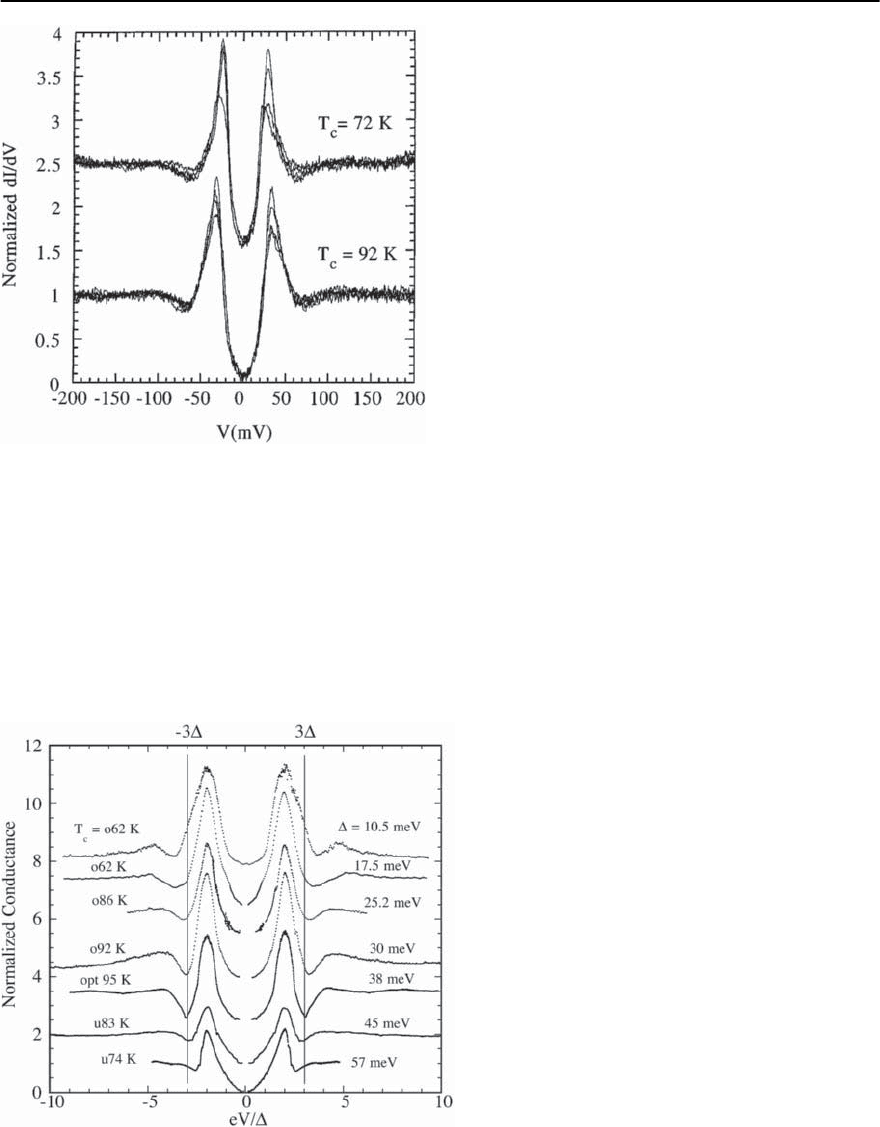
15 Tunneling Spectroscopy 855
Fig. 15.24.NormalizedSTM conductanceof Bi2212foropti-
mal doped and overdoped samples from DeWilde et al.[30]
tunneling results of DeWilde et al. [30] in Fig. 15.24
for two crystals, one near optimal doping (T
c
=93
K) and another that is overdoped (T
c
=77K).The
data from many junctions at various locations on
the surface have been normalized by a smooth back-
ground and plotted together. There is generally good
agreement among the different junctions. The nor-
malization has removed some of the asymmetry but
not all of it. There remains a difference in the peak
heights and the strength of the dip but it is clearly
seen for both voltage polarities and is approximately
at 2. Also, the normalized data indicates that the
dip drops below unity by about 15%, again consis-
tent with strong coupling effects. This magnitude is
about ten times larger than observed in Nb, but this
is consistent with the much larger gap size.
Oneoftheearliestnotionsaboutthedipfeature
was that it might be a proximity effect.As Figs. 15.14
and 15.15 show,dip features can arise from the prox-
imity effect however in those cases the main con-
ductance peak is either an induced gap (McMillan
model) or a bound state (Arnold model) in the N
layer and therefore would always be at a lower energy
than the true gap.Also the conductance peak voltage
would depend on details of the surface N layer and
thus would be material dependent,an effect which is
not observed. Most importantly, the dip/hump fea-
ture in proximity effect models would be a closer
measure of the underlying superconducting gap and
for tunneling data on Bi2212 this would give an over-
estimateof thegapvalueby a factorof twoor three.As
noted before,Raman scattering which is bulk probe,
matches the gap vs. doping curve in Fig. 15.20 and
therefore the tunneling conductance peak gives the
correct value of the superconducting gap. Thus the
Fig. 15.25. SIS tunneling conductances at various dop-
ing levels showing the shift of the dip feature with T
c
.
Voltage axis is rescaled in units of /e, from [68]
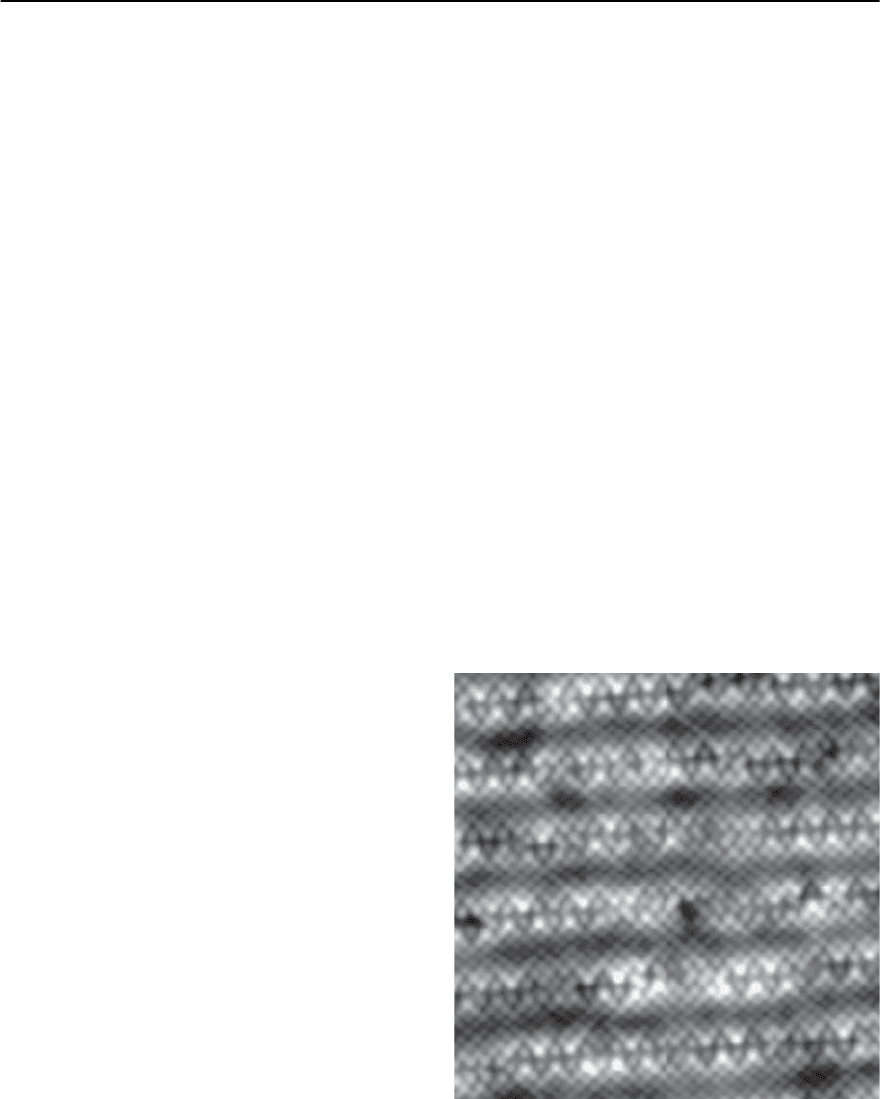
856 J.Zasadzinski
dip/hump features are not consistent with any prox-
imity effect interpretation.
Further insight into the dip is found in SIS
break junctions where the feature is much more
pronounced. More recent data from the Argonne
group [68] is shown in Fig. 15.25. Here the voltage
axis has been rescaled in units of /e. If the dip in
the SIN spectra was exactly at E =2, then it should
appear at 3 in the SIS plots but Fig. 15.25 shows
that there is a systematic shift of the dip feature with
doping. This dip in the SIS junctions is found to be
at 2 +§ where § =4.9kT
c
. This scaling is nearly
the same as found in neutron scattering for the reso-
nance spin excitation [69,70].Thus it appears that the
dip feature can be considered a strong coupling ef-
fect analogous to phonon structures, but the bosonic
excitation that is responsible for this feature, the res-
onance spin excitation, is itself well defined only in
the superconducting state. As will be shown later, a
similar effect is seen in a heavy fermion supercon-
ductor.
15.5.3 Bi
2
Sr
2
CaCu
2
O
8
S™ Mapping
There has been a systematic improvement in the
quality of STM data on HTS cuprates in general and
on Bi2212 in particular. These are a consequence
of improved quality of crystals as well as vacuum
tunneling methods. In general, the Bi2212 crystals
can be cleaved in-situ in a UHV environment and
then measured at low temperatures. These latest gen-
eration STM measurements are providing unprece-
dented atomic resolution images of the cleaved sur-
faces which have an exposed Bi-O layer. An example
is shown in Fig. 15.26 where the Bi and O atoms can
be resolved [71]. The modulation of the Bi-O struc-
ture along the b-axis is indicated by the light and
dark fringe pattern and along the light fringes there
is a sinusoidal pattern which is not understood.Thus
suchatomically resolvedimagesprovideauniqueop-
portunity to examine the local superconducting DOS
and perhaps link the spectra to particular kinds of
defects. By examining the superconducting conduc-
tance spectra at different locations,adefect structure
is foundthat appears to be intrinsic to the Bi2212 ma-
terial.
Two such spectra are shown in Fig. 15.27 for a
slightly overdoped Bi2212 crystal from Hudson et
al. [71] The dashed line conductance looks very sim-
ilar to superconducting spectra obtained by PCT and
previous STM studies. Note the dip features found at
about 2 with the same strength as observed earlier
by DeWilde in Fig. 15.24. However, there is an addi-
tional feature, a small peak, observed just before the
dip. The origin of this feature is not understood,but
it bears a resemblance to general strong coupling fea-
tures, and it might be that the improved resolutionof
this STM spectrum is providing moredetailed strong
coupling features. This gives further credence to the
notion that the spectral region near the dip is due
to some type of quasiparticle emission process and
Fig. 15.25 is suggesting that the boson emitted seems
to be the resonance spin excitation.
The solid line curve of Fig. 15.26 has a slightly
different spectral shape, generally weaker supercon-
ducting features and a small peak near zero bias.
These types of ZBCP are common for junctions
where the tunneling direction is into the ab plane
as was discussed in the section on novel d-wave ef-
fects. They correspond to surface induced Andreev
bound states which result when a quasiparticle scat-
tering off a vacuum interface changes the sign of its
Fig. 15.26. STM image of Bi-O plane,from Hudson et al.[71]
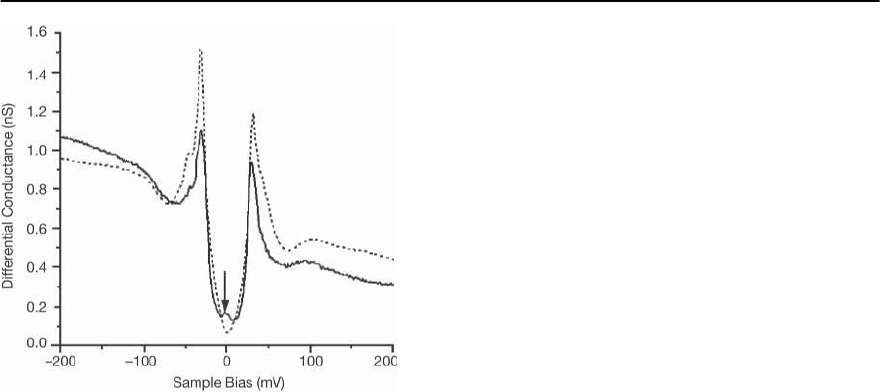
15 Tunneling Spectroscopy 857
Fig. 15.27. STM conductance spectra for the tip over a su-
perconducting region (dashed line) and a defect region
(solid line). Note the zero bias conductance peak for the
spectrum at a defect, from [71]
order parameter as can happen with d-wave symme-
try.Similareffectsare foundfor scattering off defects
either adjacent to the Cu-O plane or within it. Even
for elastic scattering,the quasiparticle can change its
wavevector such that the sign of the order parameter
is changed. The intrinsic defect regions are proba-
bly associated with defects that originate within the
Bi-O layer where the excess oxygen has been placed
to dope the material. Such a defect can still cause
potential scattering within the Cu-O plane.
A more striking result is obtained when a Ni or
Zn impurity is introduced directly into the Cu-O
plane [72]. Scattering off such defects leads to large
a ZBCP in the local density of states due to Andreev
bound states and a suppression of superconductivity.
An example of the spatial profile over a Zn impurity
is shown in Fig. 15.28. It is important to understand
that this is not a standard atomic image but is a spa-
tial plot of the zero bias conductance and therefore
the insulating Bi-O/Sr-O layer is acting as part of the
tunnel barrierand superconductivityof the underly-
ingCu-Oplaneis beingprobed.Thesuperconducting
regions far from the Zn impurity have a low conduc-
tancesincethisis insidethesuperconducting gapand
appear as dark regions. The brightest regions corre-
spond to the largest ZBCP where superconductivity
is weakest and the bound states exist. The dominant
peak corresponds to the tip being just above the Zn
atom. A striking feature of this image is the fourfold
symmetric pattern which is a consequenceof d-wave
symmetry.
15.5.4 Intrinsic c-Axis Junctions on Bi2212
The cuprates are layered materials,with Cu-O planes
separated by charge reservoir layers. Thus the doped
cuprates can be viewed as stacks of metallic layers
separated by thin insulating regions. Figure 15.1(e)
is a schematic representation of such a stack for a
single Cu-O plane per unit cell as in Tl2201.Whether
intrinsic tunneling phenomena can be observed in
experiments depends on the nature and magnitude
of the tunneling matrix element. For example, co-
herent tunneling occurs when transverse wavevector
is conserved and this leads to the standard Bloch
waves and band dispersion along the c-direction.
Nothing unconventional would be expected in this
case. Transport along the c-directionwould be of the
Drude type. In Bi2212,the c-axis resistivity is larger
than the maximum metallic resistivity and therefore
adjacent Cu-O bi-layers are coupled incoherently. A
single crystal along the c-axis can be viewed as a
set of incoherently coupled tunnel junctions [73].
Lithographic methods have been developed to iso-
latestacks of junctions in a mesa configuration which
contain a relatively small number (≈ 5–20) of such
SIS junctions in series. For example, three Cu-O bi-
layers in Bi2212 would act as two SIS junctions in se-
ries. These stacks exhibit Josephson effects and when
the Josephson critical current for an individual junc-
tion is exceeded, that junction switches over to the
single-electron (or quasiparticle) branch. Studies of
such intrinsic junctions were pioneered by Kleiner et
al. [74,75] and have led to an active field of study. A
thorough review of the extensive literature has been
given by Yurgens [76].
It might be assumed that such a stack of junc-
tions would provide ideal quasiparticle characteris-
tics since the Cu-O layers are perfectly aligned and
there are no exposedsurfaces whichpotentially could
effect standard tunneling geometries.However,these
intrinsic junctions have highly transmissive tunnel
